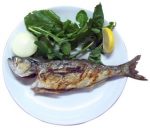Protein is an essential component of our food because it provides the building blocks the body uses to support life, but how much protein do we need each day to thrive?
Eat too much and we put on weight. Eat too little and we lose muscle mass.
Amino acids
The building blocks of proteins are called amino acids and in food the amino acids are linked together like long chains.
Before the amino acids can be used they must be liberated from the protein chains by digestion, which starts in the mouth.
Chewing a piece of protein-containing food breaks it into very small pieces and mixes it with saliva to form a kind of slurry, which is then swallowed. Mother’s advice to chew food properly was well founded!
In the stomach, acid and an enzyme called pepsin get to work on the slurry and further break the protein chains apart.
After an hour or two, the partly-digested slurry leaves the stomach and moves towards the small intestine. On the way, two enzymes from the pancreas are added to the mix (trypsin and chymoptrypsin) to break up further the protein chains.
Eventually, the chains are broken into their single components and the amino acids are absorbed into the blood stream, ready to be used.
Essential for life
Amino acids are used in a dizzying number of ways that affect your outward appearance, your mood, and how well the members of your internal biochemical orchestras play together.
For example, amino acids are necessary for:
- skin
- bone
- hair
- nails
- nerves
- enzymes
- neurotransmitters
- hormones
- antibodies
And probably a few others I’ve left off the list. As you can see, protein is absolutely essential for life.
Storage
Unlike glucose and fat, amino acids cannot be stored for later use.
If the last meal supplies amino acids in excess of the body’s immediate requirements, the liver can convert the excess amino acids to glucose, to be used to generate energy.
However, if the meal has a lot of starchy carbohydrate – fried fish and chips, for example – there will be more than enough glucose from the chips and the batter on the fish to meet energy requirements, and the liver won’t need to convert any excess amino acids to glucose. Instead, they are converted to fat and sent to the adipose tissue around the waist and hips.
Insulin controls whatever glucose is made from amino acids, which is important to remember because the purpose of low-carb-high-fat is to keep insulin production low.
And of course, if weight loss is your goal, conversion of excess amino acids to fat will not be helpful at all.
How much protein?
The amount of protein required varies from person to person and depends on factors like age, natural metabolic rate, gender, level of activity, and so on. There’s not a one-size-fits-all recommended amount.
A good guide for most people is to put on your plate at each meal a piece of meat the size and thickness of the palm of your hand.
Or if you want to be more precise, weigh your protein to provide about 0.8 to 1.0 gm of protein per day, for each kilogramme of body weight.
Weighing food is a bit of a drag, but it’s worth the effort at the start. One you get the hang of things, you’ll be able to leave the kitchen scale in the cupboard.
For example, my weight hovers between 71 and 72 kg. So for me, 72 x 0.8 = 57.6 gm is the lower limit, and I could go to 72 x 1 = 72 gm each day.
There would be no advantage to eating more protein than I need because it would be converted to fat and parked where I don’t want it.
On the other hand, eating less protein than 57 gm would not provide enough for my life processes, and my body’s chemistry would make up the shortfall by taking protein from my muscles.
As a compromise, I aim between the lower and upper limit, about 67 gm of protein a day. But I don’t stress about it. Sometimes I eat a little more protein, and sometimes a little less.
Protein content of food


There’s water in most foods, and bones and gristle in fish and meats, so trying to figure out how much actual protein there is in the meat or fish on your plate, or even in the vegetables, is not easy.
And to make it more complicated, some protein is more easily digested and readily available than other types.
Have a look at the list of protein foods on Wikipedia and you’ll see what I mean.
Online food tracking
At the start of changing to a low-carb-high-fat lifestyle, it’s difficult to know from which food groups your calories are coming, and in what proportions.
For the last couple of weeks I’ve been using a really superb online facility to record what I eat.
I enter the foods, and the software calculates how many calories come from protein, how many from fat, and how many from carbohydrate in a day. And I can even see the vitamins and minerals.
It’s been a really useful tool to show me the composition of my meals. After I get used to the various food quantities I’ll probably stop using it… but maybe not. It’s quite addictive!
If you’d like to find out more about it for yourself, nip over to my food tracker page where there’s a short intro and a link to sign up for free.

Pingback: How added sugar harms us and what to do about it | Thrive Low Carb
Pingback: Fix weight loss stall, slow loss, or gain | Thrive Low Carb
Pingback: Apple cider vinegar treats gastric reflux | Thrive Low Carb